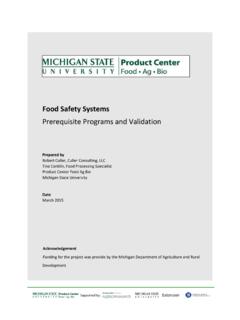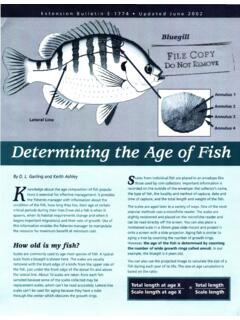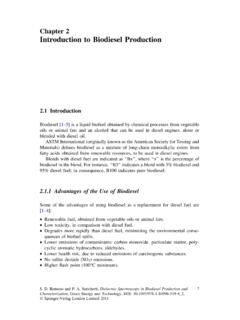Transcription of Livestock Injection Methods & Placement
1 4-H Animal Science Anywhere | Michigan 4-H Youth Development | Michigan State University Extension Copyright 2016 Michigan State University Board of Trustees. Michigan State University is an affirmative action/equal opportunity HEALTH ACTIVITYL ivestock Injection Methods & PlacementSkill Level: 4 Intermediate to advancedLife Skills: 4 Communication, critical thinking and decision makingSetting: 4An outdoor or indoor space with a supply station, tables and an easy-to clean floor; seating is optionalTime: 420 25 minutesMaterials: Flipchart or other large paper Markers Pens or pencils (one per participant) Easel or display space Disinfectant wipes or spray Disposable latex or nitrile gloves (one pair per person) (Note: Be sure to provide gloves of various sizes, and if anyone in the group is allergic to latex, provide nitrile gloves.) Sharps container, either commercial or homemade (a labeled, puncture-proof container with a lid, duct-taped closed when done with the activity) Duct tape Permanent marker Trash bag (one or more, depending on the size of your group) Injection Kits (one per person or team, plus one demonstration kit): 4 New medical syringe and 16- to 21-gauge needle.
2 (Note: 18-gauge needles and syringes that come with the needles attached and that are designed for one-time use are recommended.) 4 Disposable dinner plates (one per kit) 48-ounce disposable cups (one per kit) 4 Injectable solution: about 3 ounces of water and about 30 drops (a little more than 1/3 teaspoon) of blue or green food coloring per kit 4 Paper towels (at least one sheet per participant) 4 One of the following per person: about 3 ounces of chicken breast meat (with or without skin), an unpeeled yellow (not green) banana, an unpeeled orange 4 Metric ruler (one per kit, optional) Injection Methods and Procedures handout (one per participant) Sample Veterinary Medication Label handout OR the actual label from a veterinary medication bottle that is empty and has been thoroughly rinsed (one per participant, optional) Reading a Veterinary Medication Label Worksheet (one per participant, optional) Michigan 4-H Animal Treatment Record Sheet (one per participant, optional)Overview.
3 The Livestock Injection Methods and Placement lesson is designed to add a visual and hands-on component to an important topic for understanding the different types of Injection Methods used in Livestock management. As a team, participants will discuss and identify important components of each Injection method and be able to know where and how to give each Injection type on various Livestock and practice the hands-on method of giving an :After completing this activity, participants will be able to: 4 Discuss and identify five Injection Methods and where on an animal s body the injections are typically given. 4 Describe why injections are given using different Methods and in different places on an animal s body. 4 Demonstrate how to give two different types of injections (intramuscular or IM and subcutaneous or SC). 4 Explain why some veterinary medications are delivered by Injection . 4 Read and identify six things from an injectable veterinary medication label: the name of the medication, why it s used, the proper dosage, the Injection method to use, whether the medication has a withdrawal time and what it is, the medication s expiration Animal Science Anywhere | Michigan 4-H Youth Development | Michigan State University Extension Copyright 2016 Michigan State University Board of Trustees.
4 Michigan State University is an a rmative action/equal opportunity HEALTH ACTIVITYPROCEDURE:Before the meeting:1. Review the lesson and gather any supplies you will Recruit at least one adult or older teen volunteer who is experienced at giving injections for every two pairs of participants. Give the helpers a copy of the lesson and encourage them to review it before the meeting, paying close attention to the safety information and the photos showing the proper techniques for each Injection Use the information in Table 1 to decide whether to have the participants practice giving intramuscular (IM) and subcutaneous (SC or SQ) injections on chicken breast meat (with or without skin), yellow bananas, unpeeled oranges, or some Use the supplies from the materials list to prepare one Injection Kit for each participant or team and one for you to use in demonstrating the Injection Methods to the group. Place one practice injec-tion subject (chicken breast meat, yellow banana or unpeeled orange), one syringe and needle com-bination, and at least one sheet of paper towel per team member on each plate.
5 If the needles and syringes you ll be using are packaged separately, put a needle (with the cap still on) on each syringe. Prepare the Injection solution by filling disposable cups about one-third full of water . Add enough blue or green food coloring (about 30 drops or 1/3 tea-spoon) to make the solution deep blue or Set the completed kits, the Injection solution and the disposable gloves on a table or container near the front of the meeting space. (Note: You may want to assign someone to watch over the plates containing the needle-syringe combinations before the meeting starts.)6. Recreate the structure and headers only (no data) of Table 2 on flipchart paper. (Note: If you have a large group or the teams will be spread out over a large area as they work, you may want to make and dis-play several large copies of the blank table around the room. If you do this, have volunteers fill out the other flipcharts at the same time you re working on the one at the front of the room.)7. Buy or make a sharps container from an empty, rinsed out, puncture-proof container with a lid, such as a laundry detergent jug or a coffee can.
6 Label both sides of the container with Danger Medical Sharps Disposal Container in permanent Make one copy per participant of the following handouts and worksheets: Injection Methods and Procedures worksheet Reading a Veterinary Medication Label handout (optional) (Note: You could also have participants inspect the labels of clean, empty bottles of injectable animal medications for this activity.) Veterinary Medication Label Worksheet (optional)9. Meet with the helpers you recruited before the meeting starts. Explain that their primary responsibility during the lesson will be to keep the Table 1. Choosing Model Patients for Intramuscular (IM) and Subcutaneous (SC or SQ) InjectionsPotential model patientSuitability as model for intramuscular (IM) injectionsSuitability as model for subcutaneous (SC or SQ) injectionsChicken breast meat (skinless)Most realistic option because it mimics the texture participants will encounter when injecting live animals, but it s also the most option because there is no skin to inject solution under and it s breast meat (with skin)Most realistic option because it mimics the texture participants will encounter when injecting live animals, but it s also the most realistic option because it mimics injecting an animal.
7 Can also be challenging because the skin is bananaUsable option, but hard to see Injection results without peeling away the option because the skin is thick. Can be more challenging to inject into the skin because the skin is more densely packed than the skin of other orangeUsable option, but hard to see Injection results without peeling away the option because the skin is thick and there are large air pockets between the skin and the flesh of the Animal Science Anywhere | Michigan 4-H Youth Development | Michigan State University Extension Copyright 2016 Michigan State University Board of Trustees. Michigan State University is an a rmative action/equal opportunity HEALTH ACTIVITY participants and themselves safe. This means, among other things: Keeping track of the needles and syringes the participants in their group are using at all times. Monitoring the participants in the group to ensure that they re handling the needles and syringes safely. Helping with cleanup after the Injection activity to make sure the needles and syringes are collected and disposed of properly in the sharps container.
8 (Note: If you plan to have your group work on the medication label inspection part of the lesson, tell the helpers that you may need them to check the partici-pants completed Reading a Veterinary Medication Label Worksheets, too.)During the meeting:Important Safety NoteIt s vital that you discuss safe handling of syringes, needles and medication (and Livestock !) with the group before passing out any part of the Injection Kits. Further, we recommend distributing the sy-ringes and needles only after everyone is ready for that part of the activity. Bored or restless partici-pants may play with any supplies within reach, po-tentially missing the safety discussion and thereby creating a dangerous Introduce the activity by reading aloud or paraphrasing the following:Today we re going to talk about injecting medications into Livestock . We ll cover why we deliver some medications by Injection rather than in the animal s feed or water , how and why different Injection Methods are used for different conditions, and the safety issues related to giving injections.
9 Then you ll practice giving two kinds of injections: intramuscular or IM and subcutaneous or If you re going to have the group do the label reading activity, explain that they ll also learn how to read a medication label and what to do if the label on an injectable medication doesn t specify the Injection method or site to Next, ask the group the following questions. You may want to record their answers on flipchart paper and display the sheet where everyone can read it. 4 What are the two basic reasons for delivering medication to an animal by Injection ? To prevent a healthy animal from developing the diseases it s being vaccinated against (and to keep it from developing complications from those diseases). to treat a sick or injured animal. 4 Why are some medications delivered by Injection rather than in an animal s feed or water ? So that the Livestock producer knows for sure that the animal has actually received a set dose of medication, rather than relying on the chance that it will get some or all of a dose from its feed or water .
10 Because sick animals often go off feed, that is, they don t eat or drink much or at all. If they re not eating or drinking, they won t get any of the medication that has been put into their feed or Now read aloud or paraphrase the following:Animal Injection Methods aren t that different from human Injection Methods . We all have muscles, veins and layers of skin, which are all useful places to inject various wouldn t be practical or fair to the animal for all of us to practice giving injections to the same steer, lamb or hog at one meeting. So we re going to learn about and practice giving injections to model patients [chicken breast meat/yellow bananas/unpeeled oranges] instead of live Now ask for volunteers to name one Injection method or place on an animal s body where we give injections. You may want to record their answers on flipchart paper and display the paper where everyone can see it. Note that it s okay if the participants don t know the scientific names for the Injection Methods .










